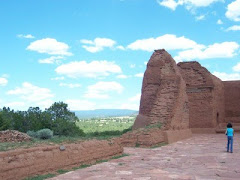
 They break away from their roots in the autumn, driven by the wind. Rootless, wind-tossed tumbleweeds are large enough in Santa Fe to plonk into the side of your car and cause damage, not to mention alarm among vehicle occupants.But tumbleweeds are not native here. They are Russian thistle from the arid shrub steppes of the Ural Mountains. They snuck into America in the 1870s with flax seed brought by Ukrainian farmers and spread across the West. A Hopi name for tumbleweed translates as "white man's plant." It's also called "wind witch."
They break away from their roots in the autumn, driven by the wind. Rootless, wind-tossed tumbleweeds are large enough in Santa Fe to plonk into the side of your car and cause damage, not to mention alarm among vehicle occupants.But tumbleweeds are not native here. They are Russian thistle from the arid shrub steppes of the Ural Mountains. They snuck into America in the 1870s with flax seed brought by Ukrainian farmers and spread across the West. A Hopi name for tumbleweed translates as "white man's plant." It's also called "wind witch."By the time the Sons of the Pioneers recorded "Tumbling Tumbleweeds" in 1934, this bizarre weed came to symbolize restless Western culture. They keep spreading because tumbleweed drops seeds - a single plant can produce up to 200,000 seeds. They are a symbol of what happens when we tinker with the balance of arid environments.
Tumbleweeds, the cartoon character, by T.K. Ryan; see http://www.tumbleweeds.com/.
Russian thistle photo from DesertUsa.com.








